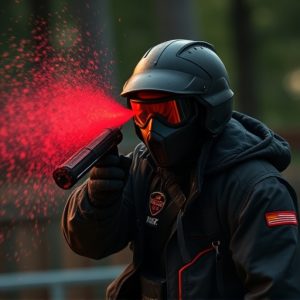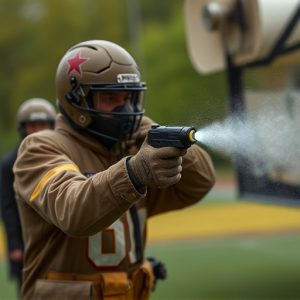Pepper Spray Self-Defense Guide: Composition, Vision Impact, and Legal Use
Pepper spray, a non-lethal self-defense tool, contains oleoresin capsicum (OC) and is effective in …….
Pepper spray, a non-lethal self-defense tool, contains oleoresin capsicum (OC) and is effective in temporarily incapacitating attackers by causing severe eye and respiratory irritation. It induces a stinging sensation and uncontrollable lacrimation, significantly impairing vision within moments without leading to true blindness. The effects, which include swelling of the conjunctiva and cornea, reduce visual acuity for 30 to 45 minutes, providing an opportunity to escape or seek help. It's important to note that while pepper spray can cause temporary "blinding," it does not result in permanent blindness; its effects are intense but temporary. The legality of pepper spray varies by jurisdiction, so users must adhere to local laws regarding its use, which include carry limits and application restrictions. When selecting a pepper spray, factors such as Scoville Heat Units (SHU), formula, and delivery system should be considered for optimal effectiveness in self-defense situations. Proper training is essential for effective deployment of the spray, ensuring users can confidently react to threats while understanding its limitations as part of a broader personal safety strategy.
When faced with an unexpected confrontation, personal safety becomes a paramount concern. Understanding self-defense options, such as pepper spray, is crucial for those looking to protect themselves effectively and legally. This article delves into the efficacy of pepper spray—commonly known as mace—by exploring its chemical makeup, how it functions, and its impact on an attacker’s vision, addressing concerns like “Can pepper spray blind you?” It also navigates the legal implications involved in its use. Additionally, we guide readers through selecting the most appropriate pepper spray for their self-defense needs, emphasizing training and proper usage for optimal safety outcomes.
Understanding Pepper Spray: Composition, Mechanism, and Effectiveness
Pepper spray, a non-lethal self-defense tool, is widely recognized for its role in deterring attacks and providing individuals with a means to escape dangerous situations. The primary active component in pepper spray is oleoresin capsicum (OC), derived from natural sources like cayenne peppers. This irritant triggers an intense inflammatory response upon contact with the mucous membranes of an attacker, which include the eyes, nose, and lungs. When discharged, the fine mist or liquid penetrates deep into the respiratory system and eyes, causing immediate incapacitation by inducing a burning sensation that can temporarily blind the assailant, rendering them disoriented and unable to see, as the spray targets the sensitive trigeminal nerves. The effects of pepper spray are not limited to temporary blindness; it also causes significant coughing, difficulty in breathing, and skin irritation, which collectively hinder an attacker’s ability to pursue their aggressive actions.
The effectiveness of pepper spray is a result of its well-understood mechanism and consistent performance across various environments and attack scenarios. It is important to note that while it can blind momentarily, the spray’s effects are not solely confined to vision impairment; it also severely limits an individual’s ability to react physically. The concentration and delivery system of the spray play crucial roles in its potency; a higher concentration typically means more intense effects. Users must understand the limitations and proper usage of pepper spray, as it serves as a deterrent rather than a definitive solution for self-defense. Proper aiming and technique are essential to maximize the spray’s effectiveness and ensure safety for both the user and bystanders. Regular training and familiarity with local laws and regulations governing the use of pepper spray can further enhance its utility as a personal defense tool.
The Impact of Pepper Spray on Vision: Can It Cause Temporary Blindness?
Pepper spray, a common self-defense tool, is designed to incapacitate an assailant by causing intense irritation to the eyes and respiratory system. The active ingredient in pepper sprays, Oleoresin Capsicin (ORC), is responsible for its potent effects. When deployed, it can cause a stinging sensation and uncontrollable tearing in the eyes of an attacker. The impact on vision is immediate and profound; it does not lead to temporary blindness in the traditional sense but rather creates conditions that are functionally equivalent. The spray’s particles penetrate deep into the eyes, leading to swelling of the conjunctiva and cornea, which significantly reduces visual acuity. This effect can last for upwards of 30 to 45 minutes, giving the victim a crucial window to escape from danger or for law enforcement to apprehend an attacker. It’s a misconception that pepper spray can permanently blind someone; however, its effects are disabling enough to effectively serve as a non-lethal deterrent in self-defense situations. Understanding the capabilities and limitations of pepper spray is crucial for those considering it as part of their personal safety plan.
Legal Considerations for Using Pepper Spray as a Self-Defense Tool
When considering the legal landscape surrounding self-defense sprays like pepper spray, it’s crucial to understand the varying laws across different jurisdictions. Pepper spray, a non-lethal self-defense tool, is designed to temporarily incapacitate an attacker by causing irritation to their eyes and respiratory system. Its effectiveness in self-defense situations is well-documented; indeed, a single spray can render an assailant momentarily unable to see or breathe, potentially allowing for escape or the opportunity to shout for help. However, the legality of using pepper spray for self-defense varies by state and country. In some regions, it’s legal to carry pepper spray for personal protection without restrictions, while in others, there may be specific regulations dictating its use, such as the amount of chemical allowed or the conditions under which it can be used. It’s imperative to research and adhere to local laws, as using pepper spray outside of these legal parameters could result in criminal charges. Moreover, the question of whether pepper spray can “blind” someone is a matter of legal interpretation; while it does not cause permanent blindness, the intense burning and temporary loss of vision can be disorienting and debilitating to an attacker, thereby fulfilling its intended purpose as a deterrent and defensive tool. Users must familiarize themselves with the law in their locale, ensuring they understand both the rights and responsibilities associated with possessing and using pepper spray for self-defense.
Choosing the Right Pepper Spray for Personal Safety: Factors to Consider
When selecting a self-defense spray, understanding the variety of options available and their implications for personal safety is crucial. Pepper sprays are a popular choice among personal defense tools due to their effectiveness and legal status in many regions. One puff of pepper spray can temporarily impair an assailant’s vision, range from 4 to 15 feet, and cause intense irritation to the eyes and respiratory system. This incapacitating effect can buy valuable time for you to escape or seek help.
However, not all pepper sprays are created equal. The strength of the spray is measured in Scoville Heat Units (SHU), with higher SHU levels causing more intense effects. For personal safety, a spray with 10% major capsaicinoids (active ingredient) is often recommended as it can effectively deter attackers. Additionally, consider the type of delivery system—keychain models, for instance, offer convenience and quick access in an emergency. Other factors to consider include the spray’s formula, which may target both the eyes and skin or specifically the eyes, the quantity of spray per can, and the type of pepper used, as some peppers are more potent than others. Always ensure that your chosen pepper spray is compliant with local laws and regulations, and that it suits your individual needs and comfort with its use. Understanding the capabilities and limitations of pepper spray is essential in determining if it’s the right self-defense tool for you. Can pepper spray blind you? While it can cause temporary blindness by causing an intense burning sensation that forces the eyes shut, it does not “blind” someone permanently; vision typically returns within 45 minutes after exposure to fresh air. Therefore, when evaluating pepper sprays, focus on factors like concentration, delivery system, and legal compliance to select a product that aligns with your personal safety strategy.
Training and Proper Use of Pepper Spray for Effective Self-Defense
When it comes to self-defense, the proper training and use of pepper spray are paramount for its effectiveness. Pepper spray, also known as OC (oleoresin capsicum) spray, is a non-lethal self-defense tool that can incapacitate an attacker by causing inflammation and pain in their eyes, skin, and respiratory system. Understanding how to effectively deploy the spray during an altercation is critical. Training should cover the correct techniques for aiming and using the spray, as well as situational awareness to recognize threats before they escalate. It’s also important to be aware of local laws and regulations regarding pepper spray use, as these can vary by region.
Proper training will also address concerns such as whether can pepper spray blind you temporarily. While the spray is designed to disorient and cause temporary pain, it should not cause permanent blindness. However, its effects are potent enough to provide a significant defensive advantage. Users must practice using the spray in controlled environments to familiarize themselves with its range and effects. This hands-on approach ensures that when faced with an actual threat, one can react quickly and confidently, maximizing the spray’s effectiveness while minimizing the risk of accidental exposure to bystanders or oneself. Regular training also helps users understand the limits of pepper spray as a self-defense tool and reinforces the need for it to be part of a broader personal safety strategy that includes verbal assertiveness, avoiding high-risk situations, and knowing when and how to seek help from law enforcement or security personnel.


